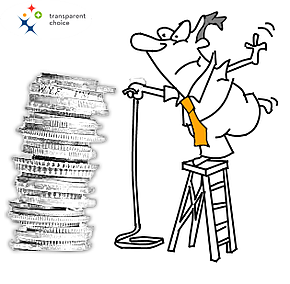What is Picking Projects Worth to a PMO?
Updated:
Published:
 The life of PMO is sometimes thankless. If things go badly, it’s all your fault. If they go well, you don’t get the credit.
The life of PMO is sometimes thankless. If things go badly, it’s all your fault. If they go well, you don’t get the credit.
I was reminded of this during a recent conversation with a PMO who’d taken on the role around a year-and-a-half ago…. Then I discovered that he’s no longer in the PMO role….
He’s been promoted.
He got promoted because he got results, and project prioritization was a significant part of his focus. So it got me wondering… what is good project prioritization worth?
The Cost of Poor Project Prioritization
To work out what it’s worth, we have to think about what poor prioritization costs.
And let’s not fool ourselves. MOST organizations do a poor job of prioritization (see if you’re one). Here are some scary statistics (regular readers will have seen these before):
-
86% of organizations under-deliver on the value of their projects by at least 25%
-
58% of projects are not aligned with corporate strategy
-
87% of organizations don’t formally check the strategic alignment of project portfolios
So what are the costs of poor prioritization? I’m going to outline three areas that lead to waste – but there are more.
-
Poor prioritization means that you tend to have projects on the books that aren’t really needed. This can show up as obsolete projects, poor executive sponsorship or poor project performance. One PMO told me “Around one third of projects were obsolete before they were even finished. With a combined investment of around €20 million, this was a significant problem,”.
-
Where projects are not being aligned with strategic goals, there is an “opportunity cost” - the money you spent could have earned you more if you’d spent it a different way. This opportunity cost can be captured in a statement something like, “Last year our $10m spend delivered $20m value to our organization, but if we’d picked the best projects we’d have delivered $30m. Our opportunity cost was $10m.”
-
Your people are not daft. Year after year, they see failed projects, projects that are obsolete before they are complete, etc. If they suspect they’re working on one of these projects, there is a tendency for them to – whisper it – not work as hard as they might on your project. This has an obvious, negative impact on project delivery.
Hidden Benefits
These are all clear, easy concepts to grasp. But there are other, softer benefits to good prioritization.
First, your project teams will be able to more effectively manage their time. They will be able to clearly see where to apply resources to deliver the most value, and will be able to make the inevitable trade-offs that are necessary in any project. This helps keep them motivated and gets them out of the political firing line.
Next, a well-structured process for prioritizing and selecting projects will mean less executive time. Paradoxically, the reduced time spent selecting projects doesn’t mean that they are less engaged. In fact, by being the engine for setting priorities, the business “owns” the priorities directly and are able to make decisions more quickly.
Finally, a good prioritization process is transparent. Everyone knows what the goals of the organization are, what the priorities are for the business – and these can be clearly captured in a “decision model”. As such, when a department head requests a project, they can get instant feedback on the fit of their project with corporate priorities. And these are smart people… once they see clear priorities and understand the success-criteria, they will start thinking planning differently and will propose projects that are better aligned with priorities. So you’ll get to pick the best projects out of a stronger pool of potential projects raising the value of the portfolio even further.
Don’t Take My Word for It
I love this quote from a PMO who had just implemented a new and well-structured project prioritization and selection process. “It’s too early to say exactly how much we will save with TransparentChoice’s project portfolio management tool, but it will create millions of Euros of value.”
And yes, you’ve guessed it. He’s the PMO at the start of this blog, the one who got promoted.
So what’s the value of better project prioritization? Well, we often see an increase in return from the project portfolio of 10%-20% for the organization. If your portfolio is worth $10m per year, that would translate into $1m-$2m in extra value.
Each year.
But for the people involved in selecting the projects, for those implementing projects and for those requesting projects, the reduced stress is potentially priceless!
And for the PMO? Well, what is success worth?
How to improve your project prioritization?
A great way to get going is to do a quick portfolio audit to see how you're doing today and to identify quick wins.
The output of the audit is a report telling you:
-
How well aligned is your portfolio with strategy
-
Identify which projects are doing well and which ones are struggling
-
Clear recommendations to improve alignment and how to address failing projects
